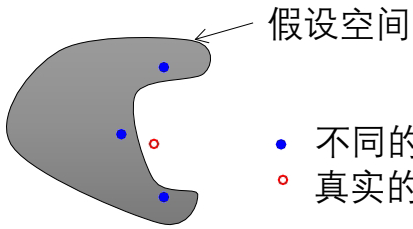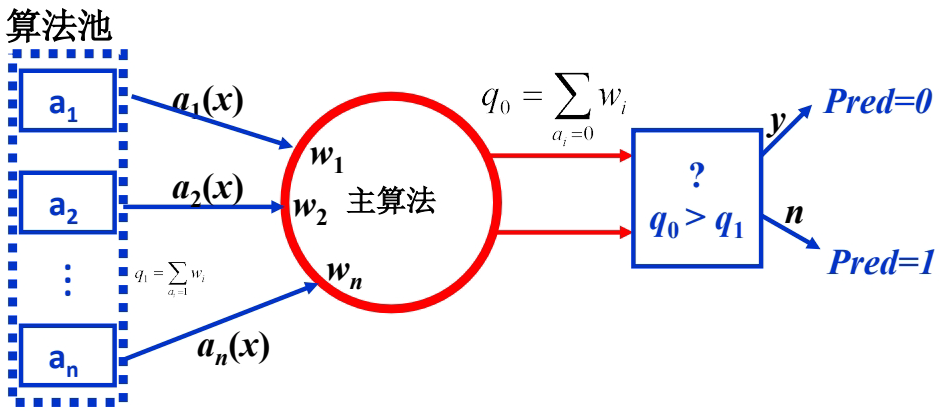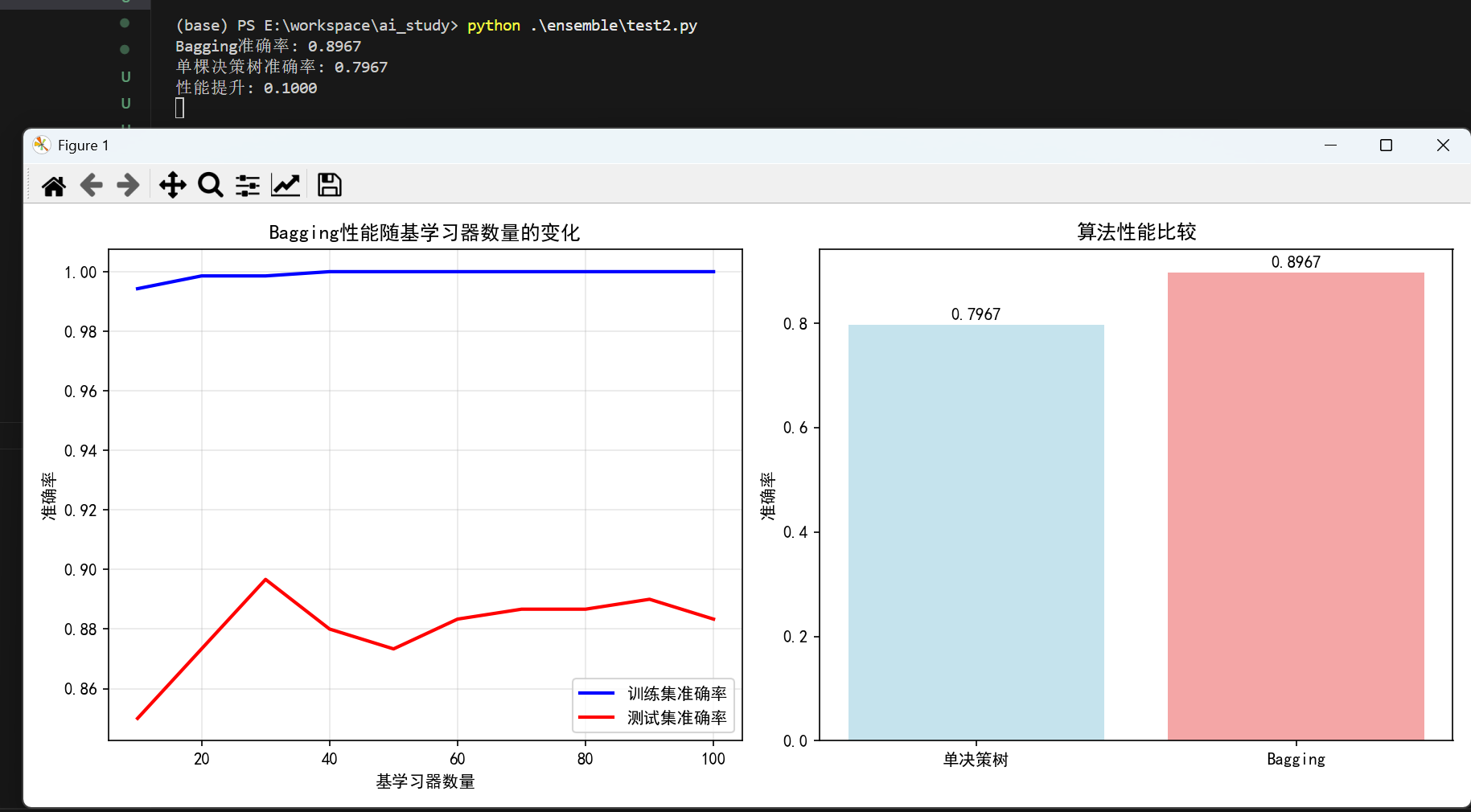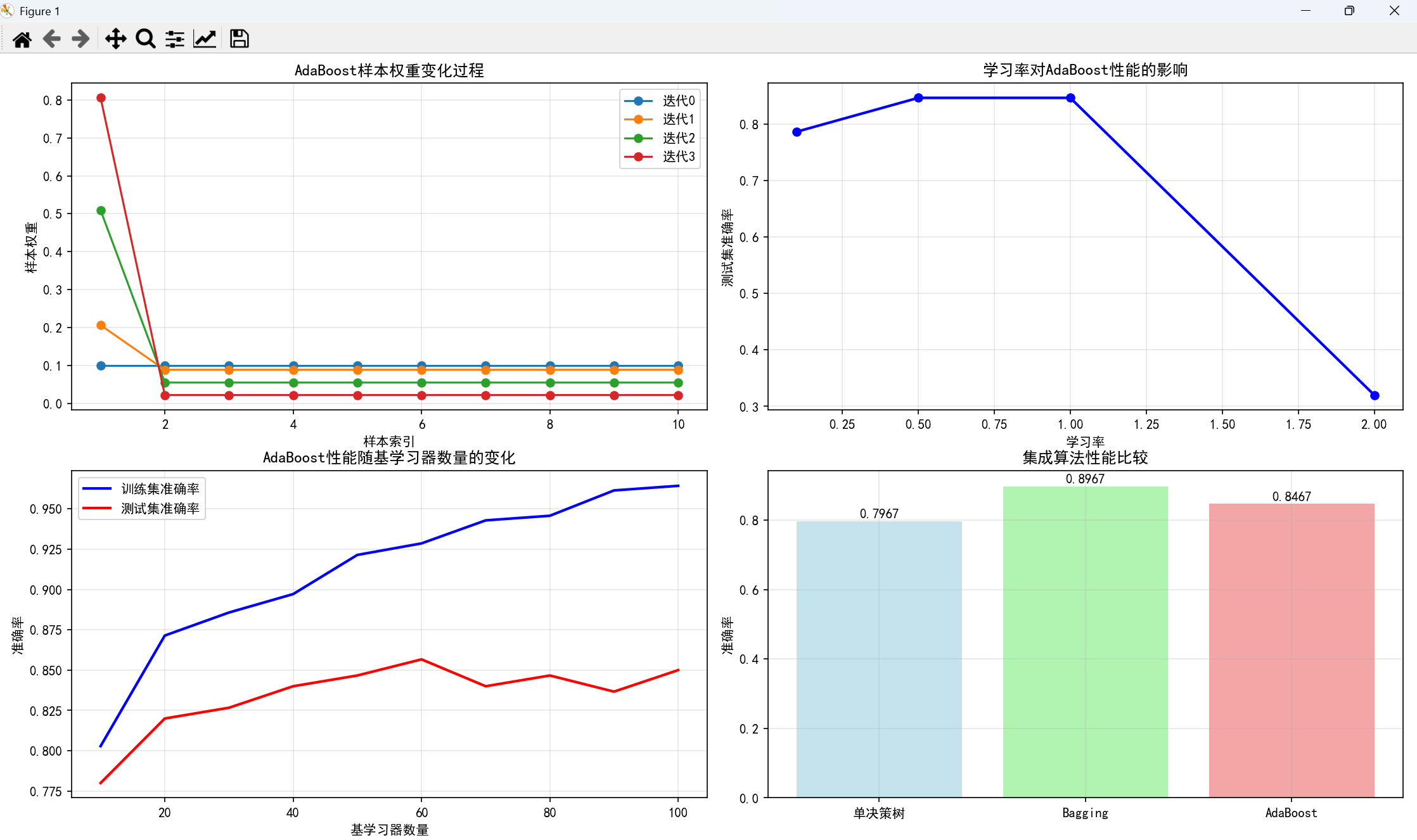「机器学习笔记14」集成学习全面解析:从Bagging到Boosting的Python实战指南
三个臭皮匠,顶个诸葛亮。在机器学习领域,集成学习正是这一智慧的最佳体现。
一、什么是集成学习?
集成学习(Ensemble Learning)是一种通过构建并结合多个学习器来完成学习任务的机器学习方法。其核心思想是:将多个弱学习器组合起来,形成一个强学习器,从而获得比单一学习器更优越的性能。
1.1 集成学习的理论基础
为什么集成学习有效?主要有四个关键原因:
1. 经验法则的局限性
- 很容易找到非常正确的"经验法则",但很难找到单个高准确率的规则
- 多个近似正确的规则组合起来可能达到更好的效果
2. 假设空间的多解性 当训练样本很少而假设空间很大时,可能存在多个同样精度的假设。选择某一个假设可能在测试集上效果较差,而集成多个假设可以降低风险。
3. 避免局部最优 算法可能会收敛到局部最优解。融合不同的假设可以降低收敛到不好局部最优的风险。
4. 假设空间的局限性 真实假设可能不在当前算法定义的假设空间中,但多个近似假设的组合可能更好地逼近真实假设。

1.2 强学习器 vs 弱学习器
- 强学习器:有高准确度的学习算法
- 弱学习器:在任何训练集上可以做到比随机预测略好(错误率 error=1/2−γ\text{error} = 1/2 - \gammaerror=1/2−γ)
集成学习的关键问题:我们能否把一个弱学习器增强成一个强学习器?
二、集成学习的主要方法
2.1 加权多数算法(Weighted Majority Algorithm)
加权多数算法是最早的集成学习方法之一,适用于二分类问题。
算法原理
预测阶段:
-
每个算法 aia_iai 对输入 xxx 产生二值输出 {0,1}\{0,1\}{0,1}
-
计算加权投票:q0=∑ai=0wiq_0 = \sum_{a_i=0} w_iq0=∑ai=0wi,q1=∑ai=1wiq_1 = \sum_{a_i=1} w_iq1=∑ai=1wi
-
最终预测:如果 q0>q1q_0 > q_1q0>q1 则预测为0,否则预测为1

训练阶段:
- 初始化所有权重 wi=1w_i = 1wi=1
- 对每个训练样本 ⟨x,c(x)⟩\langle x, c(x) \rangle⟨x,c(x)⟩:
- 计算加权投票并作出预测
- 对预测错误的算法:wi←βwiw_i \leftarrow \beta w_iwi←βwi(β∈[0](@ref)[1](@ref)\beta \in [0](@ref)[1](@ref)β∈[0](@ref)[1](@ref) 是惩罚系数)
Python实现示例
import numpy as np
from sklearn.base import BaseEstimator, ClassifierMixinclass WeightedMajorityClassifier(BaseEstimator, ClassifierMixin):def __init__(self, base_estimators, beta=0.5):self.base_estimators = base_estimatorsself.beta = betaself.weights = Nonedef fit(self, X, y):n_estimators = len(self.base_estimators)self.weights = np.ones(n_estimators)# 训练所有基学习器for estimator in self.base_estimators:estimator.fit(X, y)return selfdef predict(self, X):predictions = np.array([estimator.predict(X) for estimator in self.base_estimators])weighted_votes = np.dot(self.weights, predictions)return np.where(weighted_votes >= 0, 1, 0)def partial_fit(self, X, y):"""在线学习:根据新数据更新权重"""if self.weights is None:self.weights = np.ones(len(self.base_estimators))# 获取当前预测current_predictions = self.predict(X)# 更新权重for i, estimator in enumerate(self.base_estimators):estimator_prediction = estimator.predict(X)if estimator_prediction != y:self.weights[i] *= self.beta# 归一化权重self.weights /= np.sum(self.weights)return self
2.2 Bagging(Bootstrap Aggregating)
Bagging通过自助采样法构建多个训练集,分别训练基学习器,然后通过投票或平均法结合预测结果。
Bootstrap采样原理
从包含m个样本的数据集D中,有放回地随机抽取m个样本构成新的训练集 DiD_iDi。
- 每个样本在每次抽样中被抽中的概率为 1/m1/m1/m
- 一个样本在m次抽样中始终不被抽中的概率为 (1−1/m)m≈0.368(1-1/m)^m \approx 0.368(1−1/m)m≈0.368
- 因此每个自助采样集大约包含原始数据集63.2%的样本
Bagging算法流程
-
对于 t=1,2,…,Tt = 1, 2, \ldots, Tt=1,2,…,T(T个基学习器):
- 对训练集进行Bootstrap采样,得到采样集 DtD_tDt
- 用采样集 DtD_tDt 训练基学习器 hth_tht
-
对分类任务采用投票法,对回归任务采用平均法
Python实战示例
from sklearn.ensemble import BaggingClassifier
from sklearn.tree import DecisionTreeClassifier
from sklearn.datasets import make_classification
from sklearn.model_selection import train_test_split
from sklearn.metrics import accuracy_score
import matplotlib.pyplot as plt
import numpy as np# 生成示例数据
X, y = make_classification(n_samples=1000, n_features=20, n_informative=15, n_redundant=5,random_state=42)X_train, X_test, y_train, y_test = train_test_split(X, y, test_size=0.3, random_state=42)# 创建Bagging分类器
bagging_clf = BaggingClassifier(estimator=DecisionTreeClassifier(),n_estimators=50,max_samples=0.8, # 每个基学习器使用80%的样本max_features=0.8, # 每个基学习器使用80%的特征bootstrap=True, # 使用Bootstrap采样random_state=42
)# 训练和评估
bagging_clf.fit(X_train, y_train)
y_pred_bagging = bagging_clf.predict(X_test)
bagging_accuracy = accuracy_score(y_test, y_pred_bagging)# 比较单个决策树
single_tree = DecisionTreeClassifier(random_state=42)
single_tree.fit(X_train, y_train)
y_pred_single = single_tree.predict(X_test)
single_accuracy = accuracy_score(y_test, y_pred_single)print(f"Bagging准确率: {bagging_accuracy:.4f}")
print(f"单棵决策树准确率: {single_accuracy:.4f}")
print(f"性能提升: {(bagging_accuracy - single_accuracy):.4f}")# 可视化不同基学习器数量对性能的影响
n_estimators_range = [10, 20, 30, 40, 50, 60, 70, 80, 90, 100]
train_scores = []
test_scores = []for n in n_estimators_range:clf = BaggingClassifier(estimator=DecisionTreeClassifier(),n_estimators=n,random_state=42)clf.fit(X_train, y_train)train_scores.append(accuracy_score(y_train, clf.predict(X_train)))test_scores.append(accuracy_score(y_test, clf.predict(X_test)))plt.figure(figsize=(12, 5))plt.subplot(1, 2, 1)
plt.plot(n_estimators_range, train_scores, 'b-', label='训练集准确率', linewidth=2)
plt.plot(n_estimators_range, test_scores, 'r-', label='测试集准确率', linewidth=2)
plt.xlabel('基学习器数量')
plt.ylabel('准确率')
plt.title('Bagging性能随基学习器数量的变化')
plt.legend()
plt.grid(True, alpha=0.3)plt.subplot(1, 2, 2)
# 比较不同算法的性能
methods = ['单决策树', 'Bagging']
accuracies = [single_accuracy, bagging_accuracy]
colors = ['lightblue', 'lightcoral']plt.bar(methods, accuracies, color=colors, alpha=0.7)
plt.ylabel('准确率')
plt.title('算法性能比较')
for i, v in enumerate(accuracies):plt.text(i, v + 0.01, f'{v:.4f}', ha='center')plt.tight_layout()
plt.show()
运行结果:

Bagging的有效性条件
Bagging在学习器"不稳定"时效果最好:
- 不稳定学习器:训练集小的差异可以造成产生的假设大不相同
- 典型代表:决策树、神经网络
- 稳定学习器(如K近邻)使用Bagging效果提升有限
2.3 Boosting(提升方法)
Boosting方法顺序训练基学习器,每个后续学习器更关注前一个学习器错误分类的样本。
AdaBoost算法详解
AdaBoost(Adaptive Boosting)是最著名的Boosting算法:
算法流程:
-
初始化样本权重:wi=1/Nw_i = 1/Nwi=1/N(所有样本权重相等)
-
对于 t=1,2,…,Tt = 1, 2, \ldots, Tt=1,2,…,T:
- 用当前权重分布训练基学习器 hth_tht
- 计算错误率:ϵt=∑i=1Nwi⋅I(yi≠ht(xi))\epsilon_t = \sum_{i=1}^N w_i \cdot I(y_i \neq h_t(x_i))ϵt=∑i=1Nwi⋅I(yi=ht(xi))
- 计算学习器权重:αt=12ln(1−ϵtϵt)\alpha_t = \frac{1}{2} \ln\left(\frac{1-\epsilon_t}{\epsilon_t}\right)αt=21ln(ϵt1−ϵt)
- 更新样本权重:
- 正确分类:winew=wiold⋅e−αtw_i^{\text{new}} = w_i^{\text{old}} \cdot e^{-\alpha_t}winew=wiold⋅e−αt
- 错误分类:winew=wiold⋅eαtw_i^{\text{new}} = w_i^{\text{old}} \cdot e^{\alpha_t}winew=wiold⋅eαt
- 归一化权重(使权重和为1)
-
最终分类器:H(x)=sign(∑t=1Tαtht(x))H(x) = \text{sign}\left(\sum_{t=1}^T \alpha_t h_t(x)\right)H(x)=sign(∑t=1Tαtht(x))
Python实战示例
from sklearn.ensemble import AdaBoostClassifier
from sklearn.tree import DecisionTreeClassifier
import matplotlib.pyplot as plt
import numpy as np# 创建AdaBoost分类器(使用决策树桩)
adaboost_clf = AdaBoostClassifier(estimator=DecisionTreeClassifier(max_depth=1), # 弱学习器:决策树桩n_estimators=50,learning_rate=1.0,random_state=42
)# 训练和评估
adaboost_clf.fit(X_train, y_train)
y_pred_adaboost = adaboost_clf.predict(X_test)
adaboost_accuracy = accuracy_score(y_test, y_pred_adaboost)print(f"AdaBoost准确率: {adaboost_accuracy:.4f}")# 可视化训练过程中样本权重的变化
plt.figure(figsize=(15, 10))# 模拟AdaBoost权重更新过程
def simulate_adaboost_weights(n_samples=10, n_iterations=3):# 初始权重weights = np.ones(n_samples) / n_samplesweight_history = [weights.copy()]for iteration in range(n_iterations):# 模拟错误率(假设第一个样本被错误分类)error_rate = 0.3 if iteration == 0 else 0.2# 计算alphaalpha = 0.5 * np.log((1 - error_rate) / error_rate)# 更新权重(简化版:假设第一个样本错误分类,其他正确)for i in range(n_samples):if i == 0: # 错误分类weights[i] *= np.exp(alpha)else: # 正确分类weights[i] *= np.exp(-alpha)# 归一化weights /= np.sum(weights)weight_history.append(weights.copy())return weight_historyweight_history = simulate_adaboost_weights()plt.subplot(2, 2, 1)
for i in range(len(weight_history)):plt.plot(range(1, 11), weight_history[i], marker='o', label=f'迭代{i}')
plt.xlabel('样本索引')
plt.ylabel('样本权重')
plt.title('AdaBoost样本权重变化过程')
plt.legend()
plt.grid(True, alpha=0.3)# 不同学习率的影响
learning_rates = [0.1, 0.5, 1.0, 2.0]
lr_scores = []for lr in learning_rates:clf = AdaBoostClassifier(estimator=DecisionTreeClassifier(max_depth=1),n_estimators=50,learning_rate=lr,random_state=42)clf.fit(X_train, y_train)lr_scores.append(accuracy_score(y_test, clf.predict(X_test)))plt.subplot(2, 2, 2)
plt.plot(learning_rates, lr_scores, 'bo-', linewidth=2)
plt.xlabel('学习率')
plt.ylabel('测试集准确率')
plt.title('学习率对AdaBoost性能的影响')
plt.grid(True, alpha=0.3)# 基学习器数量对性能的影响
n_estimators_list = [10, 20, 30, 40, 50, 60, 70, 80, 90, 100]
ada_train_scores = []
ada_test_scores = []for n in n_estimators_list:clf = AdaBoostClassifier(estimator=DecisionTreeClassifier(max_depth=1),n_estimators=n,random_state=42)clf.fit(X_train, y_train)ada_train_scores.append(accuracy_score(y_train, clf.predict(X_train)))ada_test_scores.append(accuracy_score(y_test, clf.predict(X_test)))plt.subplot(2, 2, 3)
plt.plot(n_estimators_list, ada_train_scores, 'b-', label='训练集准确率', linewidth=2)
plt.plot(n_estimators_list, ada_test_scores, 'r-', label='测试集准确率', linewidth=2)
plt.xlabel('基学习器数量')
plt.ylabel('准确率')
plt.title('AdaBoost性能随基学习器数量的变化')
plt.legend()
plt.grid(True, alpha=0.3)# 算法比较
plt.subplot(2, 2, 4)
algorithms = ['单决策树', 'Bagging', 'AdaBoost']
accuracies = [single_accuracy, bagging_accuracy, adaboost_accuracy]
colors = ['lightblue', 'lightgreen', 'lightcoral']bars = plt.bar(algorithms, accuracies, color=colors, alpha=0.7)
plt.ylabel('准确率')
plt.title('集成算法性能比较')# 添加数值标签
for bar, accuracy in zip(bars, accuracies):plt.text(bar.get_x() + bar.get_width()/2, bar.get_height() + 0.01, f'{accuracy:.4f}', ha='center')plt.grid(True, alpha=0.3)
plt.tight_layout()
plt.show()
执行结果:

AdaBoost的优点与注意事项
优点:
- 非常快速且易于实现
- 只有一个主要参数(迭代次数T)需要调节
- 灵活:可以与任何分类器结合
- 特别适合弱学习器
注意事项:
- 性能依赖于数据和弱学习器的选择
- 在下列情况下可能失效:
- 弱学习器太复杂(容易过拟合)
- 弱学习器太弱(αt→0\alpha_t \rightarrow 0αt→0 太快)
- 数据噪声较大
三、Bagging vs Boosting:核心差异对比
| 特性 | Bagging | Boosting |
|---|---|---|
| 训练方式 | 并行训练,各基学习器相互独立 | 顺序训练,后续学习器依赖前一个 |
| 样本权重 | 所有样本权重相等 | 动态调整样本权重,关注难样本 |
| 基学习器关系 | 相互独立,可并行化 | 强依赖,必须顺序训练 |
| 对噪声的敏感性 | 相对不敏感 | 比较敏感 |
| 方差/偏差 | 主要降低方差 | 主要降低偏差 |
| 适用场景 | 高方差模型(如深度决策树) | 高偏差模型(如决策树桩) |
四、进阶集成方法与实践技巧
4.1 随机森林(Random Forest)
随机森林是Bagging的扩展,在构建决策树时不仅对样本采样,还对特征采样。
from sklearn.ensemble import RandomForestClassifier# 创建随机森林分类器
rf_clf = RandomForestClassifier(n_estimators=100,max_depth=10,min_samples_split=2,min_samples_leaf=1,max_features='sqrt', # 特征采样bootstrap=True, # 样本采样random_state=42
)rf_clf.fit(X_train, y_train)
rf_accuracy = rf_clf.score(X_test, y_test)
print(f"随机森林准确率: {rf_accuracy:.4f}")
执行结果:

4.2 重新调权 vs 重新采样
在Boosting中,有两种处理样本权重的方式:
重新调权:直接使用样本权重训练基学习器
- 优点:更精确地反映样本重要性
- 缺点:需要学习器支持样本权重
重新采样:根据样本权重进行采样
- 优点:兼容性更好
- 缺点:引入采样随机性
# 重新采样实现示例
from sklearn.utils import resampledef boosting_resampling(X, y, base_estimator, n_estimators=50):estimators = []alphas = []# 初始权重sample_weights = np.ones(len(X)) / len(X)for t in range(n_estimators):# 根据权重重新采样indices = resample(range(len(X)), replace=True, n_samples=len(X), random_state=42+t, weights=sample_weights)X_resampled = X[indices]y_resampled = y[indices]# 训练基学习器estimator = base_estimator.fit(X_resampled, y_resampled)y_pred = estimator.predict(X)# 计算错误率和alphaerror_mask = (y_pred != y)error_rate = np.sum(sample_weights[error_mask])alpha = 0.5 * np.log((1 - error_rate) / error_rate)# 更新权重sample_weights[~error_mask] *= np.exp(-alpha) # 正确分类sample_weights[error_mask] *= np.exp(alpha) # 错误分类sample_weights /= np.sum(sample_weights) # 归一化estimators.append(estimator)alphas.append(alpha)return estimators, alphas
4.3 集成学习参数调优
from sklearn.model_selection import GridSearchCV# AdaBoost参数调优
param_grid = {'n_estimators': [50, 100, 200],'learning_rate': [0.01, 0.1, 1.0]
}grid_search = GridSearchCV(AdaBoostClassifier(estimator=DecisionTreeClassifier(max_depth=1), algorithm='SAMME'),param_grid,cv=5,scoring='accuracy',n_jobs=-1
)grid_search.fit(X_train, y_train)
print(f"最佳参数: {grid_search.best_params_}")
print(f"最佳交叉验证分数: {grid_search.best_score_:.4f}")
执行结果:

五、实际应用场景与最佳实践
5.1 适用场景
- 互联网内容过滤:垃圾邮件检测、内容分类
- 图像识别:人脸识别、物体检测
- 手写识别:数字识别、文字识别
- 语音识别:语音转文本、说话人识别
- 文本分类:情感分析、主题分类
5.2 最佳实践建议
-
基学习器选择原则:
- 准确性:每个基学习器至少要比随机猜测好
- 多样性:基学习器之间应该尽可能不同
- 计算效率:考虑训练和预测的时间成本
-
避免过拟合策略:
- 控制基学习器的复杂度
- 使用交叉验证选择最优参数
- 监控训练和验证集的性能差异
-
算法选择指南:
- 数据噪声大 → 优先选择Bagging
- 追求最高精度 → 尝试Boosting
- 需要稳定可解释 → 选择随机森林
六、总结
集成学习通过"群策群力"的思想,将多个弱学习器组合成强学习器,在实践中表现出色。关键要点:
- 加权多数算法:适用于算法池场景,动态调整算法权重
- Bagging:通过Bootstrap采样降低方差,适合不稳定学习器
- Boosting:通过关注难样本降低偏差,顺序提升模型性能
- 随机森林:Bagging的扩展,实践中最常用且稳定
集成学习的成功印证了"团结就是力量"的古老智慧。在实际机器学习项目中,合理运用集成学习方法,往往能够在模型性能上获得显著的提升。
实践建议:从随机森林开始尝试,如果需要更高精度再考虑梯度提升方法,始终通过交叉验证来评估模型的实际效果。
